Nanoceramic Powder Market Size
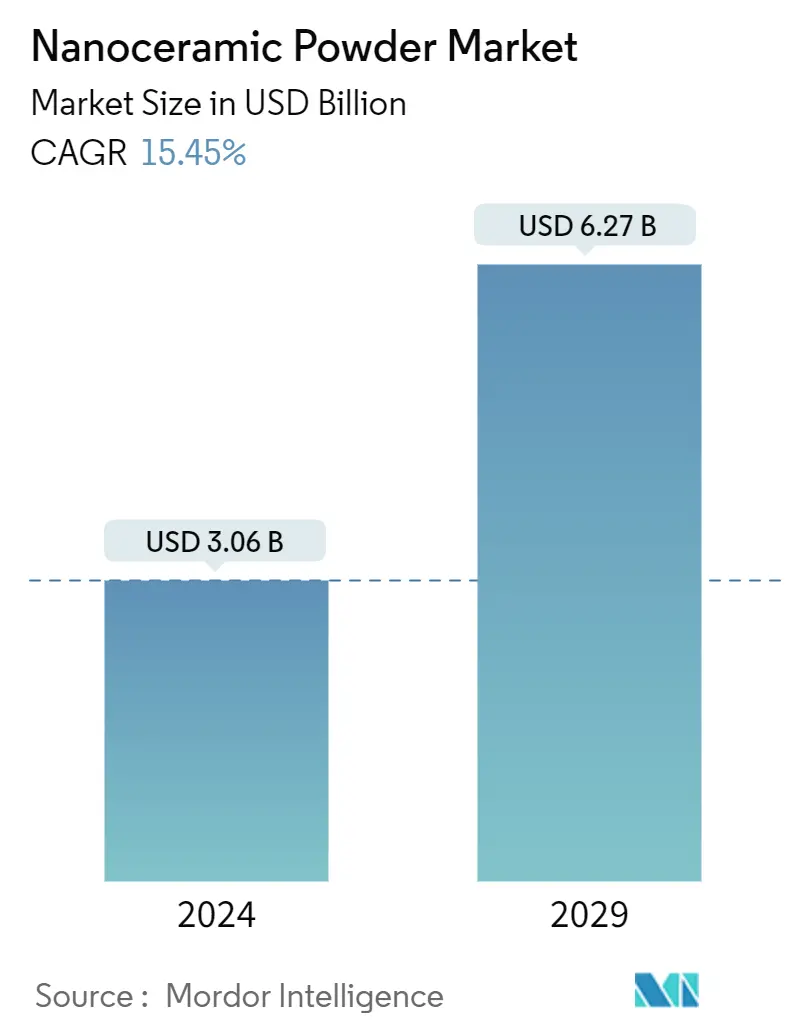
| Study Period | 2019 - 2029 |
| Market Size (2024) | USD 3.06 Billion |
| Market Size (2029) | USD 6.27 Billion |
| CAGR (2024 - 2029) | 15.45 % |
| Fastest Growing Market | Asia Pacific |
| Largest Market | Asia Pacific |
Major Players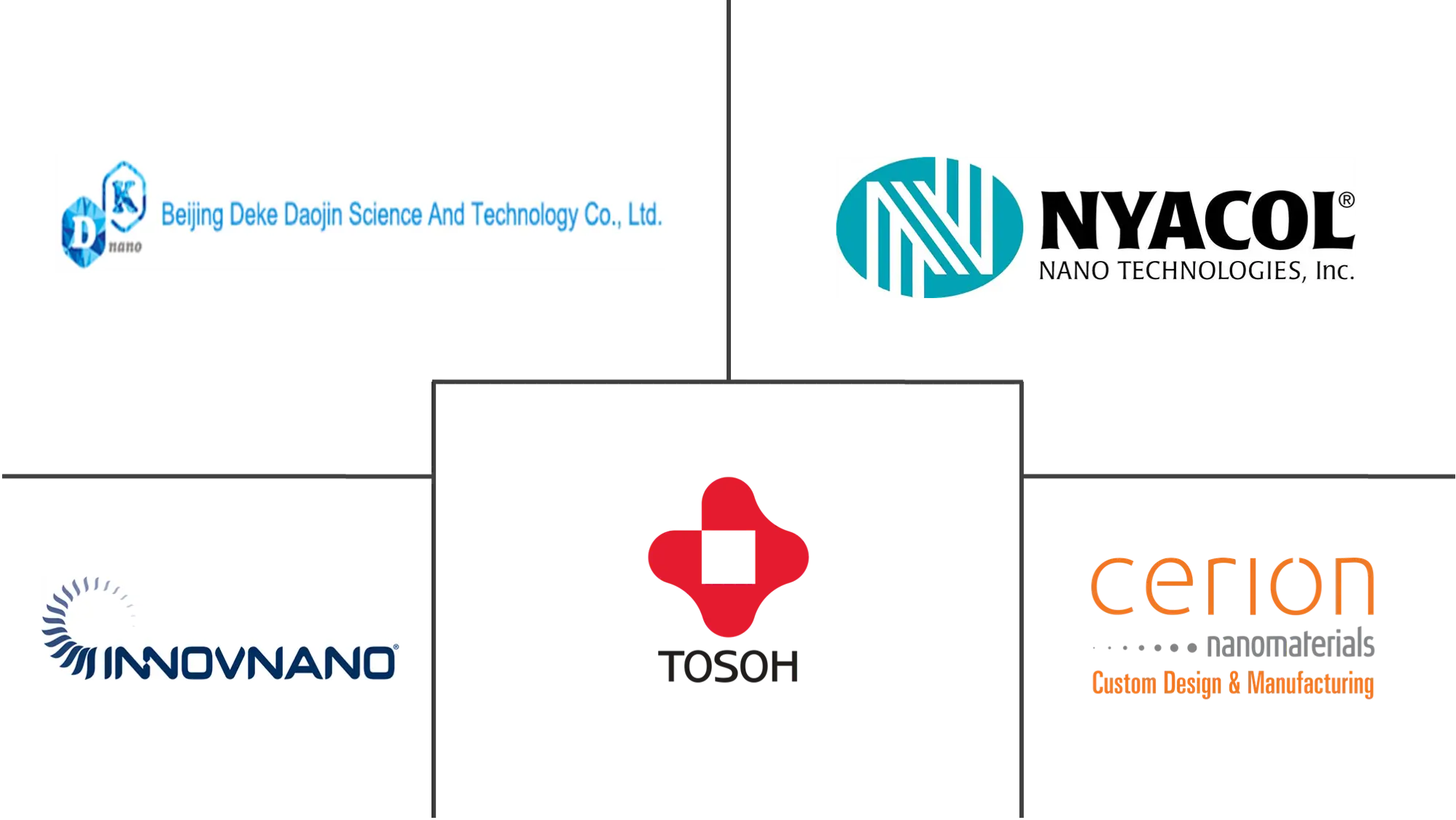
*Disclaimer: Major Players sorted in no particular order |
Need a report that reflects how COVID-19 has impacted this market and its growth?
Nanoceramic Powder Market Analysis
The Nanoceramic Powder Market size is estimated at USD 3.06 billion in 2024, and is expected to reach USD 6.27 billion by 2029, growing at a CAGR of 15.45% during the forecast period (2024-2029).
- The COVID-19 pandemic had a diverse effect on different industries, significantly impacting the demand for nanoceramics powder. The demand fluctuations were due to disruption in supply chains, reduced economic activity, and changed consumer behavior. The demand for nanoceramics powder was affected as the transportation, chemical, and industrial sectors witnessed a decreasing trend. However, since restrictions were removed, the industry has been recovering.
- A significant factor driving the market study is widespread use in the electronics industry. Additionally, increasing demand in the healthcare sector and high-performance ceramic coatings drive the nanoceramics powder market.
- The high processing costs of nanoceramic powder and health and safety issues are expected to negatively affect the growth of the nanoceramic powder between 2024 and 2029.
- Increasing applications of silicon carbide and gallium nitride and opportunities in advanced technologies, like space exploration and photovoltaic solar cells, are expected to provide new growth opportunities for the market.
- Asia-Pacific is expected to dominate the market from 2024 to 2029. The electrical and electronics sector is supported by increasing investments and export opportunities, which drive this growth.
Nanoceramic Powder Market Trends
Increasing Demand from the Electrical and Electronics Industry
- Over the last 20 years, there has been a huge amount of study into nanoceramics that has resulted in some positive outcomes for academia and industry. As a result, these advanced materials have a wide range of uses in electronics.
- Nanoceramic powders with properties like dielectricity, ferromagnetism, piezoelectricity, magnetoresistance, and superconductivity make them a perfect fit for applications in power transmission devices, industrial capacitors, high-energy storage devices, and others.
- Nanoceramic powders are used in the electronics industry, and they are traditionally used during the production of high-speed computing chips in cellular phones, portable computing devices, gaming systems, and other personal electronic devices.
- Nanoceramic alumina is most commonly used in electronics, as it can withstand a much higher voltage, so its shape can be customized based on the device size.
- The global consumer electronics industry has been growing rapidly across the world over the years due to the consistently increasing demand for cellular phones, portable computing devices, gaming systems, and other personal electronic devices. According to the Japan Electronics and Information Technology Industries Association, the total production of electronic products accounted for JPY 6,937,233 million in the first 8 months of 2023.
- According to data from the National Bureau of Statistics, China’s integrated circuit production volume reached 28.1 billion units in April 2023. The number of smartphone users in China is growing rapidly. The number of smartphone users in the country is expected to reach 868.2 million by the end of 2023.
- ASEAN has the fastest-growing consumer electronics segment in Asia-Pacific. Electrical and electronics manufacturing is one of the most prominent sectors in ASEAN. The sector accounts for about 30-35% of the total exports from the region. Most global consumer electronic products, such as radio, computers, and cellular phones, are manufactured and assembled in ASEAN countries.
- In North America, especially in the United States, the electronics industry is expected to grow at a moderate rate. An increase in the demand for new technological products is expected to help the market expansion in the future.
- The global consumer electronics market has witnessed notable growth in the past few years as the latest technological gadgets are gaining popularity. Home automation and integrating devices with personal assistance have provided noteworthy growth to the market.
- According to the Japan Electronics and Information Technology Industries Association, the production of electronic products accounted for JPY 7,891,720 million (~USD 52,864.9 million) in the first nine months (i.e., January- September) of 2023.
- All the aforementioned factors are likely to increase the demand for the market between 2024 and 2029.
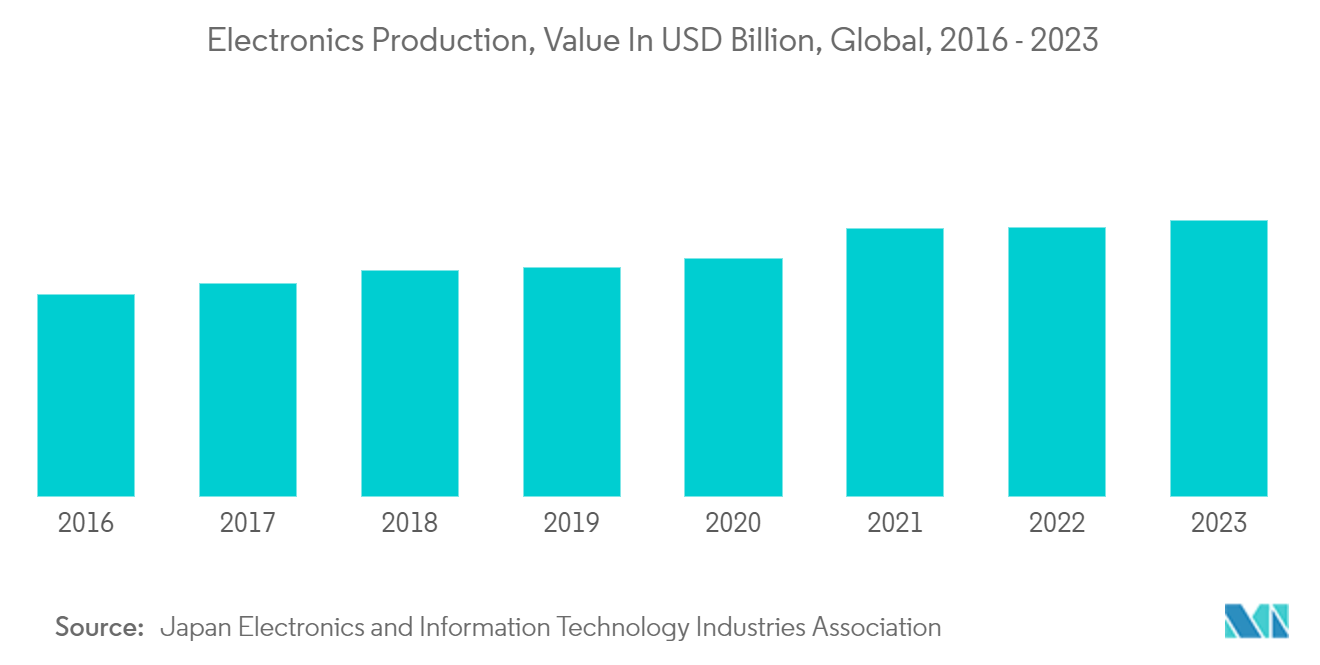
Asia-Pacific is Expected to Dominate the Market
- With over 50% of the global demand, Asia-Pacific is the most promising market for nanoceramic powder materials, which is likely to dominate the market in the near future. This domination can be attributed to the rising demand from the electronics and medical industries in the region.
- China accounts for over 33% of the demand for nanoceramic powder in this region. The country is also one of the major global markets for nanoceramic powder. Sustained demand for nanoceramic powder is witnessed here through its robust electronics, aerospace, and defense (A&D) sectors.
- China has one of the world’s largest electronics production bases and offers tough competition to the existing upstream producers, such as South Korea, Singapore, and Taiwan. Electronic products, such as smartphones, OLED TVs, and tablets, have the highest growth rates in the consumer electronics segment of the market in terms of demand. According to the National Bureau of Statistics of China, retail sales of household appliances and consumer electronics in China amounted to almost CNY 61 billion (USD 8.52 billion) in April 2023.
- Moreover, according to the India Brand Equity Foundation (IBEF), the Indian electronics manufacturing industry is expected to reach USD 520 billion by 2025. Additionally, India is expected to become the world's fifth-largest consumer electronics and appliances industry by 2025. Electrical and electronics production in India is expected to increase rapidly due to government initiatives with policies, such as Make in India, National Policy of Electronics, Net Zero Imports in Electronics, and Zero Defect Zero Effect, which offer a commitment to growth in domestic manufacturing, lowering import dependence, energizing exports, and manufacturing.
- The region is also the largest manufacturer of automobiles, with China and India contributing to maximum production capacity and ASEAN countries joining the expanding market. China is the largest automobile market globally and plays a pivotal role in the global automotive sector. In 2022, vehicle production in China reached a notable total of 27.02 million units, marking a 3% increase compared to the previous year (26.09 million units). The substantial production volume in China signifies a robust demand for automotive materials, including nanoceramic powder, to support this thriving industry.
- Moreover, China is one of the largest aircraft manufacturers and one of the largest markets for domestic air passengers. Moreover, the country's aircraft parts and assembly manufacturing sector has been growing rapidly, with the presence of over 200 small aircraft parts manufacturers.
- Since the use of nanoceramic powder is important in high-grade military equipment and parts of military aircraft, engines, and fighter jets, the market for nanoceramic powder looks promising from 2024 to 2029 in the region.
- The Chinese government announces defense expenditure information annually. China announced a defense budget of CNY 1.55 trillion (USD 224.8 billion) in March 2023. This represents a nominal 7.2% increase from the CNY 1.45 trillion (USD 229.6 billion) budget in 2022.
- Overall, with the consistent growth in China and India, the demand for nanoceramics powder is expected to increase at a faster pace in the overall region in the coming years. The huge growth of Asia-Pacific is quite instrumental in the expansion of the global nanoceramics powder market.
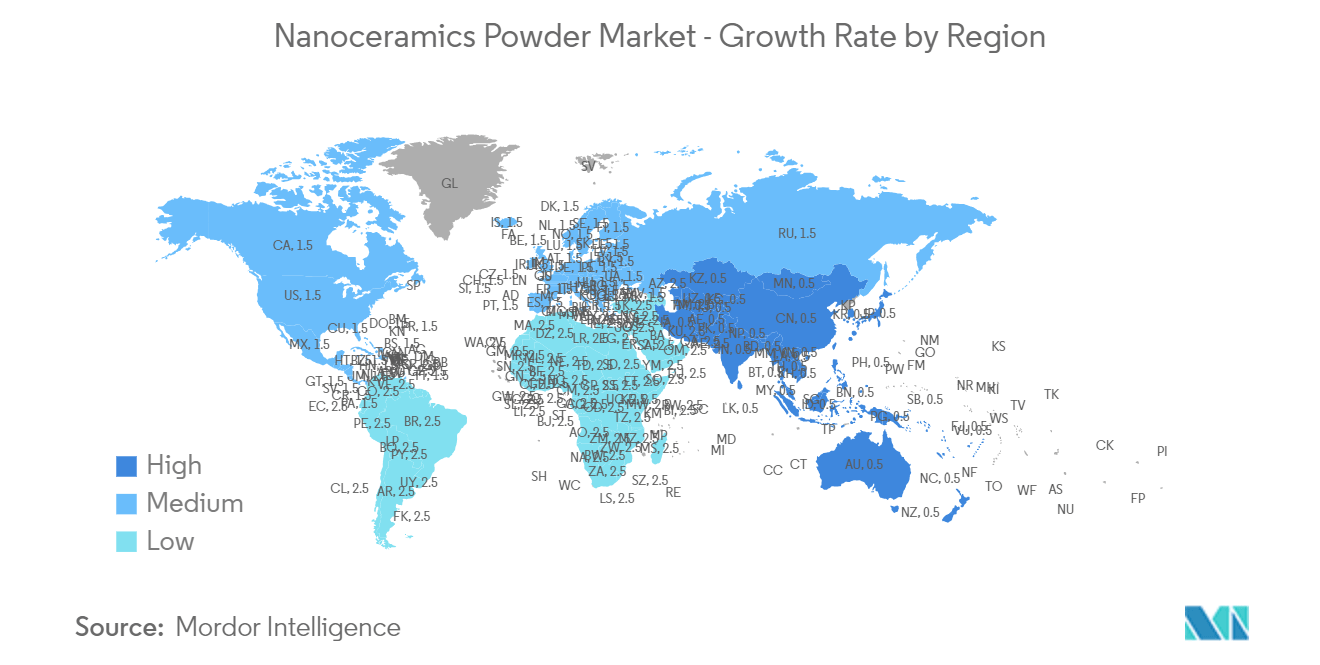
Nanoceramic Powder Industry Overvview
The global nanoceramic powder market is oligopolistic and partially consolidated, with few players dominating the market. The major companies include Tosoh Corporation, Beijing DK Nano Technology Co. Ltd, NYACOL Nano Technologies Inc., Innovnano-Materiais Avancados SA, and Cerion LLC.
Nanoceramic Powder Market Leaders
Tosoh Corporation
Beijing DK Nano Technology Co. LTD
NYACOL Nano Technologies Inc.
Innovnano-Materiais Avancados SA
Cerion, LLC
*Disclaimer: Major Players sorted in no particular order
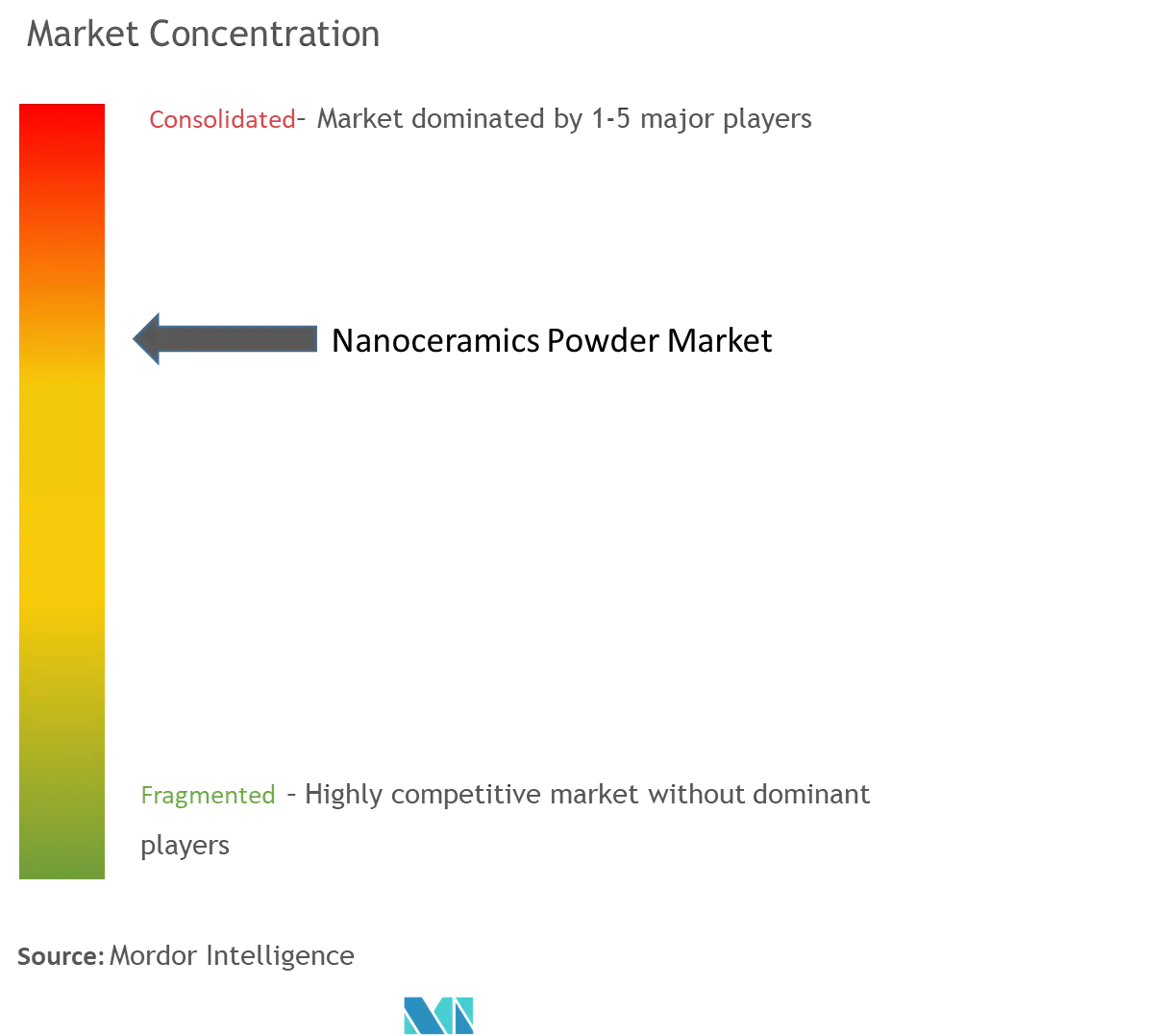
Nanoceramic Powder Market News
Recent developments pertaining to the major players in the nanoceramics powder market are being covered in the complete study.
Nanoceramics Powder Market Report - Table of Contents
1. INTRODUCTION
1.1 Study Assumptions
1.2 Scope of the Study
2. RESEARCH METHODOLOGY
3. EXECUTIVE SUMMARY
4. MARKET DYNAMICS
4.1 Drivers
4.1.1 Widespread Use in the Electronics Industry
4.1.2 Increasing Demand from the Healthcare Sector
4.1.3 Increasing Demand for High-performance Ceramic Coatings
4.2 Restraints
4.2.1 High Processing Cost
4.2.2 Other Restraints
4.3 Industry Value Chain Analysis
4.4 Porter's Five Forces Analysis
4.4.1 Bargaining Power of Suppliers
4.4.2 Bargaining Power of Buyers
4.4.3 Threat of New Entrants
4.4.4 Threat of Substitute Products and Services
4.4.5 Degree of Competition
4.5 Patent Analysis
4.6 Raw Material Analysis
5. MARKET SEGMENTATION
5.1 Type
5.1.1 Oxide Powder
5.1.2 Carbide Powder
5.1.3 Nitride Powder
5.1.4 Boron Powder
5.1.5 Other Types
5.2 End-user Industry
5.2.1 Electrical and Electronics
5.2.2 Industrial
5.2.3 Transportation
5.2.4 Medical
5.2.5 Chemical
5.2.6 Defense
5.2.7 Other End-user Industries
5.3 Geography
5.3.1 Asia-Pacific
5.3.1.1 China
5.3.1.2 India
5.3.1.3 Japan
5.3.1.4 South Korea
5.3.1.5 Rest of Asia-Pacific
5.3.2 Europe
5.3.2.1 Germany
5.3.2.2 United Kingdom
5.3.2.3 France
5.3.2.4 Italy
5.3.2.5 Rest of Europe
5.3.3 North America
5.3.3.1 United States
5.3.3.2 Canada
5.3.3.3 Mexico
5.3.4 Rest of the World
6. COMPETITIVE LANDSCAPE
6.1 Market Ranking Analysis
6.2 Strategies Adopted by Leading Players
6.3 Company Profiles
6.3.1 ABM Advance Ball Mill Inc.
6.3.2 Beijing DK Nano Technology Co. Ltd
6.3.3 Cerion LLC
6.3.4 Inframat Advanced Materials LLC
6.3.5 Innovnano-materiais Avancados SA
6.3.6 Nanophase Technologies Corporation
6.3.7 NYACOL Nano Technologies Inc.
6.3.8 Tosoh Corporation
6.3.9 Trunnano
- *List Not Exhaustive
7. MARKET OPPORTUNITIES AND FUTURE TRENDS
7.1 Opportunities in Advanced Technologies, Like Space Exploration and Photovoltaic Solar Cell
7.2 Increasing Applications of Silicon Carbide and Gallium Nitride
Nanoceramic Powder Industry Segmentation
Nanoceramic powder is nanoparticles composed of ceramics, generally classified as inorganic, heat-resistant, and non-metallic solids made of metallic and non-metallic compounds. These inorganic solids comprise oxides, ceramics, carbonates, and carbides.
The nanoceramics powder market is segmented by type, end-user industry, and geography. By type, the market is segmented into oxide powder, carbide powder, nitride powder, boron powder, and other types. By end-user industry, the market is segmented into electrical and electronics, industrial, transportation, medical, chemical, defense, and other end-user industries. By geography, the market is segmented into Asia-Pacific, Europe, North America, and Rest of the World. For each segment, the market sizing and forecasts were made on the basis of revenue (USD).
| Type | |
| Oxide Powder | |
| Carbide Powder | |
| Nitride Powder | |
| Boron Powder | |
| Other Types |
| End-user Industry | |
| Electrical and Electronics | |
| Industrial | |
| Transportation | |
| Medical | |
| Chemical | |
| Defense | |
| Other End-user Industries |
| Geography | |||||||
| |||||||
| |||||||
| |||||||
| Rest of the World |
Nanoceramics Powder Market Research FAQs
How big is the Nanoceramic Powder Market?
The Nanoceramic Powder Market size is expected to reach USD 3.06 billion in 2024 and grow at a CAGR of 15.45% to reach USD 6.27 billion by 2029.
What is the current Nanoceramic Powder Market size?
In 2024, the Nanoceramic Powder Market size is expected to reach USD 3.06 billion.
Who are the key players in Nanoceramic Powder Market?
Tosoh Corporation, Beijing DK Nano Technology Co. LTD, NYACOL Nano Technologies Inc., Innovnano-Materiais Avancados SA and Cerion, LLC are the major companies operating in the Nanoceramic Powder Market.
Which is the fastest growing region in Nanoceramic Powder Market?
Asia Pacific is estimated to grow at the highest CAGR over the forecast period (2024-2029).
Which region has the biggest share in Nanoceramic Powder Market?
In 2024, the Asia Pacific accounts for the largest market share in Nanoceramic Powder Market.
What years does this Nanoceramic Powder Market cover, and what was the market size in 2023?
In 2023, the Nanoceramic Powder Market size was estimated at USD 2.59 billion. The report covers the Nanoceramic Powder Market historical market size for years: 2019, 2020, 2021, 2022 and 2023. The report also forecasts the Nanoceramic Powder Market size for years: 2024, 2025, 2026, 2027, 2028 and 2029.
Nanoceramic Powder Industry Report
Statistics for the 2024 Nano Ceramic Powder market share, size and revenue growth rate, created by Mordor Intelligence™ Industry Reports. Nano Ceramic Powder analysis includes a market forecast outlook 2029 and historical overview. Get a sample of this industry analysis as a free report PDF download.
